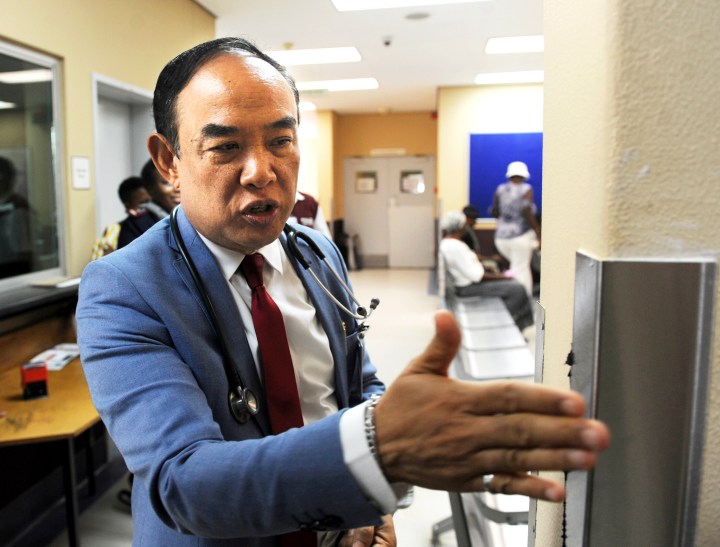Maverick Citizen: Spotlight
Mamelodi Hospital: A promising new start after the 2019 handcuffing scandal

Mamelodi Hospital in Pretoria made headlines in May 2019 when 76-year-old Martha Marais was found handcuffed to a bench in the facility’s Accident and Emergency section. Spotlight visited the hospital to see what has changed.

Dr Naing Soe, CEO of Mamelodi Hospital.
(Photo: Rosetta Msimango/Spotlight)
Now, the hospital has a new chief executive officer – Dr Naing Soe – who promises to turn the premises into “a five-star hospital”.
Soe started his tenure in November – one of 11 chief executive officers recently appointed by Gauteng Health MEC Bandile Masuku at public hospitals around the province.
‘Fire baptism’
On May 28 2019, on the same day that saw Masuku sworn in as Health MEC, Martha Marais was filmed distressed and handcuffed to a steel bench, sparking a national outcry that also grabbed the attention of the South African Human Rights Commission. In an interview with Spotlight in July last year, Masuku described the Mamelodi Hospital incident as his ‘fire baptism’, adding that this particular hospital should be used as a benchmark for his progress in office.

Mamelodi Hospital.
(Photo: Rosetta Msimango/Spotlight)
Inside the hospital, addressing Spotlight in his office on the second floor of the red brick hospital building, Soe points out the improvements he spearheaded.
“This hospital was built 10 years ago,” he says. “Over 10 years it has been totally neglected. When I got here it was terrible. When I arrived here, I took complete accountability. I repair, I paint. For example, one light was broken. But people are not accountable. And by not buying a globe for that one tube, this light, for example, in ICU might have been broken for 10 years. Not me. I fix it immediately. I buy new furniture. I mean in casualty, we have new chairs for the staff. There was no proper equipment, you know not even the microwave or fridge. Those were broken.”
Leaning back in a swivel chair, Soe gestures out the window at the terracotta roof and grounds beyond.
“You will see the lawn, it is kept, the roses are blooming and beautiful,” he says. “The roof tiles have been repaired. Over the last 10 years, presumably nobody repaired the roof. It was leaking while patients were suffering inside. When it rained, buckets were on the floor for the leaking water. Within a short period of time, I have repaired it. All of the roof is repaired and painted.
“There are no more potholes in the tar roads,” he continues. “Before November 2019, about four months ago, the tar roads were filled with potholes, the grass was overgrown, the roses wild. There were no road signs. All of that I changed.”
Soe speaks in staccato bursts, his words sharp.
At his office’s reception room, multiple quotes are pinned to a board. “Nobody learned anything by hearing himself speak,” reads a quote attributed to Richard Branson. “It doesn’t make sense to hire smart people and then tell them what to do; we hire smart people so they can tell us what to do,” is attributed to Steve Jobs.
At Mamelodi Hospital Soe now heads 337 operational beds (out of a maximum capacity of 400) with a total full-time staff of 1,200 – with 200 additional sessional workers (these are part-time or contract workers).
Why did MEC Masuku put him in charge of turning the troubled Mamelodi Hospital around?
“Forgive me if I may say,” says Soe. “I don’t want to say anything about anybody. But, personally, myself as a leader, I believe that in the Third World, in a developing country like this, you must have a lot of knowledge. Not only clinical knowledge – but about finance, about human resources, also infrastructure. If I may say, in the whole country, patients are not happy. Staff are demoralised. Morale is so low especially because of very poor working environments. I think poor governance and poor supervision, a lack of support and lack of infrastructure, these are not conducive to creating good working environments.
“For example, if you don’t supervise, a doctor will see five to 10 patients a day. If you really make their working environment conducive, this doctor will quickly see 20 patients a day. If you show as a leader, you are generous, you are kind. The nurse, also the same. The cleaner, also. It was bad when I arrived here, it was terrible. Those floors were so dirty. I mean, in four months’ time, the cleaners are now so motivated. You may witness now the floors are shining everywhere. Before, so many of the lights were not working. It was ghostly. Patients were waiting in the dark. But now they are fixed, it is beautiful. Most of the toilets were not working, not flushing, but we repair [sic] it.
“So, these are the things I’m improving, to make the working environment conducive. And also, a reward system is very important. At Tshwane I make an Employee of the Month Award, and also at the end of the year a CEO Award. Recognition for people’s work. Fortunately, all the managers here at Mamelodi are really good. They are now right behind me, supporting me.”
Soe glows with enthusiasm. This despite a bout of food poisoning that saw him in bed in the run-up to our interview. He laughs, relaying how he chugged a Red Bull minutes earlier to sharpen up.
From zero to hero
The 56-year-old general practitioner’s track record includes reportedly turning Tshwane District Hospital around, where he was chief executive officer for nearly 10 years – from 1 March 2010 until 31 October 2019.
“In 2010, then MEC, Mrs Qedani Mahlangu, appointed me at Tshwane District Hospital,” says Soe. “In 10 years’ time, I take that hospital from zero to hero. You may go and see now, it is state of the art, like a five-star hotel. I did a lot of innovation myself. It is beautiful. Better even than a private hospital. It was visited by the public protector, by minister (Nkosazana) Dlamini-Zuma, even the (Gauteng) premier David Makhura. They were so amazed and happy. They really accepted it as a five-star hospital. They gave me several awards. So that is the reason they appointed me, to transform Mamelodi Hospital, too.”
Around South Africa, a prominent gripe in health governance is a lack of funding. So where did Soe find the budget for the upgrades, both at Tshwane District and Mamelodi Hospital?
“There is budget,” says Soe. “If you use it right. Take Tshwane, I renovate over 10 years. It cost more than maybe R50-million. I purchased equipment – state of the art – for the whole hospital. Everywhere you go, there is equipment. State of the art, the best equipment and appliances. Genuine leather, not even the fake. All of this came from the infrastructure budget.”
According to Soe, the infrastructure budget at Mamelodi Hospital was R10-million for the past financial year.
“From 1 April we will get a new budget for 2020/2021,” he says. “So, I have already spoken to the senior people, hopefully, they will give me more infrastructure money. They know my commitment. Hopefully, I will get more budget for the infrastructure in the coming year.”
Soe is originally from Myanmar, where he obtained a MBBS (Bachelor of Medicine and Bachelor of Surgery) from the Institute of Medicine in Yangon, in 1998. He became a South African citizen 25 years ago.
Happy in South Africa
How did his path lead to South Africa?
“It’s a simple thing,” he says. “Myanmar is 10 times poorer than South Africa. If I may say so, South Africa is still rich. If we could just manage our resources, we should be in the first world in no time. We got diamonds, platinum, gold, all these beautiful landscapes. From tourism alone, we can be rich.
“In 1994 I heard that South Africa is looking for a foreign doctor and I went to England. There I asked, is it true? Is South Africa inviting foreign doctors? I sat for the exam at the South African embassy in London in 1994. And then I personally, I came here, I got a job. My first job started in Pretoria in July 1995. Fortunately, because it was Pretoria, visas was not a problem. My wife and five-year-old daughter arrived here in October 1995.
“For the first three years I was a medical officer, then got promoted to clinical manager. In 2010, they redeployed me to Tshwane Hospital as chief executive officer. Now, 10 years later, they promoted me again to a bigger hospital, a regional hospital – Mamelodi.”
On Soe’s desk, sits a framed photograph of his two daughters, now aged 19 and 30, both educated at Pretoria High School for Girls and the University of Pretoria.
“My first daughter, she knew no English when we arrived, but we were very fortunate, within the first year she got a progress award,” says Soe. “Now she has a BCom(-degree) in investment management and is a project leader at a bank in Singapore. My second daughter, she was born here in 2000. She got seven distinctions in matric, and a 90% average. She is first-year studying a BCom in accounting, she wants to be a chartered accountant.”
Soe credits South Africa for the rich opportunities afforded him and his family.
“I am very grateful,” he says. “Both my daughters got world-class education in South Africa, from primary school to Pretoria Girls High, to the University of Pretoria. And if you qualify from this university, the whole world recognises you. It’s a very high standard.
“So, yes I’m very happy in South Africa doing this job. And I owe South Africa a lot, that’s why I go the extra mile every day, to show my gratitude to South Africa. Even Saturday and Sunday, I come to the hospital. I work in the casualty ward, physically I see the patient. I’m a general practitioner, and here in Mamelodi, and in Tshwane, even, though I’m the CEO, day to day, and particularly Saturday and Sunday, I see the patient myself.
“Because of the demoralised staff and the unnecessary waiting time, I have no choice, I work with all my other doctors. They get really motivated when they see me do that. Because of my seniority as a clinician, I can see a lot of patients within a short time, so waiting times are shorter. It makes the patient happy. So, when I don’t have the meeting, I go to the ward, I go to casualty. If I see patients are waiting, I see them straight away. Also, we’ve cut down on meetings, we have only necessary meetings. We’re more hands-on now to work hard. I mean mostly the MEC communicate with an email or WhatsApp or something.”
Changes a year after the handcuffing scandal
Soe takes us on a tour of the hospital, pausing at the Accident and Emergency section where smartphone footage last year showed Martha Marais handcuffed to a bench.
“All of these aircons were broken, now they are fixed,” says Soe, his hand sweeping. “There was no circulation in here. Before, this site alone was flooded with people, maybe 50 patients. So, Mrs Marais was found tied here, lying on the floor. All of that happened, but no more. Then there wasn’t enough emergency trolleys, but since then we have purchased new trolleys.”
For the tour of the premises, we are joined by a throng of senior staff members including clinical manager Dr Terrence Makhudu and assistant nursing manager Naomi Masemola.
Makhudu further expounds on the incident involving Marais: “Because of the congestion patients would roam around before doctors could get to them,” he says. “Which, of course, was problematic in the ward. So, the security found her, Mrs Marais, roaming around. And the security guard tried to restrain her. Steps are being taken, staff members have been suspended, but it’s not yet concluded.”
Makhudu points out that the area is designed to accommodate 17 people in beds.
“As you can see there is still more patients than that, because of the large numbers we get,” he says. “We’re still squeezing in more beds. But what we have improved is the turn-around time, we’re able to move patients into the wards quicker.”
In addition, there are plans to upgrade the hospital’s maternity and neonatal wards, which Soe describes as “dilapidated”. This is another urgent priority given the 9,200 babies delivered at the hospital in the past year, with as many as 30 deliveries a day.
At the maternity ward, there are not enough beds. Inside a small room, 13 women about to go into labour are waiting for beds in leather easy-chairs.
“We urgently need a prenatal ward where women can wait and be monitored,” says Masemola. “This is a big challenge.”
Soe hopes to upgrade the hospital’s psychiatry ward in the near future, too.
“With the support from the MEC, I want to invite you back before Christmas to come and look,” he says. “This hospital will be five-star. In less than one year, this hospital will be one of the best in South Africa.” MC
This article was produced by Spotlight – health journalism in the public interest.





















 Become an Insider
Become an Insider